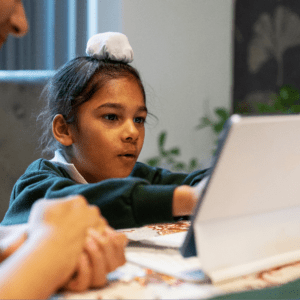Flipped learning may not be something that you’ve heard about before, and it’s even less likely that you’ve seen it done well.

It’s one of those things that seem fantastic in theory and you can find endless research about its benefits, but also a lot of stories about how it just doesn’t work; at least, not for my students.
There are some major pitfalls that teachers often fall into with flipped learning. It is often something that your students and colleagues aren’t used to, which can make the change an uphill struggle. There are some strategies that you can use if you are finding this transition difficult. First though…
What is flipped learning?
Flipped learning became very popular during the pandemic mostly due to necessity. The key feature of flipped learning is that the activities done inside and outside of class time are ‘flipped’ – a lot of what many would see as “teaching” (the introduction and clarification of concepts, or modelling) is done before the lesson so that lesson time can be spent working on more deep and complex task where the teacher and other students are present for support.
This could look like:
| Environment | Traditional Classroom | Flipped Classroom |
| During Lesson Time | – Teacher models and explains concepts. – Students ask questions to clarify. – Formative work, with feedback from teacher. – Instructions given for summative task. | – Students ask clarifying questions about concepts covered before lesson. – Students complete formative work with feedback from the teacher. – Students work on summative task with teacher input as necessary. |
| Outside of Lesson Time (Homework) | – Students complete formative tasks based on the learning during the lesson. – Students revise concepts introduced in lesson. – Work on summative tasks. | – Students watch videos/read texts that introduce and explain the concepts for next lesson. – Some formative work to assess basic understanding of the concepts. – Any additional work on summative tasks if required. |
What are the benefits of flipped learning?
As I mentioned above, one of the key benefits of flipped learning is that it can be a very efficient use of class time. If all of your students are coming to class with a sound understanding of what they need to do before they even start, then the entire lesson can be spent delving deeper into these topics.
Flipped learning is also typically very supportive of students with learning or processing difficulties. Making all of the introductory information available for them to work through at their own pace (and go back to as required) means that they are not pressured to understand it all before the end of the period is up.
What goes wrong?
There are some pitfalls with flipped learning that you also need to be prepared for. One of the most obvious ones is of course, what if they don’t do their homework??
Implementing flipped learning does not automatically mean that all of your students will suddenly become perfect students who do all of their homework all of the time. You may also have some students taking far longer to get through the homework than others, especially if they are having difficulties understanding new concepts.
You will also need to be very organised. It may take a while for you to accumulate all of the resources that you need to be able to do this properly, and many teachers will spend a hard few years recording videos every week before they have their program completely set up and ready to go. Many find it well-worth the investment to be able to skip this stuff during the lesson, though.
How do you fix it?
There are two incredibly important things that you need to do to get flipped learning to work:
- Be organised
- Be consistent
You need to have all of your homework ready to go and easy to access. Many teachers that I know who use flipped learning have a Moodle site or Google Classroom set up and pre-loaded with all of their work ready to automatically go out to students when they need it.
You will also need to be organised in a more reactive sense as well. You will need to make sure that you are tracking how much each of your students is getting through, how long it is taking them to get through it, and how much they have understood. There are a few programs designed to help you do this, EdPuzzle is a particularly good one. The key is that you want to know if a particular student is struggling and needs additional help or different resources.
You will have students who don’t do their homework. I can guarantee that the first time you try flipped learning and you expect your students to come to your first lesson ready to go, only about half of them would have done the pre-reading. It is important that you REMAIN CONSISTENT and do not deviate from your plan.
I’ve seen so many teachers give up. So many of them either say outright that it doesn’t work and scrap the idea entirely or just cave in to these students and go through the pre-reading that they missed first before going into what they had planned. The second option is actually the worst.
Why would you do the pre-reading if the teacher went through it anyway? You didn’t miss anything and this is actually easier for you because you didn’t need to do the homework. Even more so, if you did do the pre-reading but then the teacher spent the first 20mins of the lesson going through it anyway, why would you do it again next week? You’re going to need to be firm on this. You’re going to need to embarrass a few students. I don’t mean calling them out in front of the class, you don’t want to traumatise them, but you want them to know that if they continue to do this they are simply going to be left behind. They’re not going to know what’s going on if they don’t prepare.
Some teachers find this difficult, but typically it takes three weeks. Three weeks of students not doing the before-lesson work and showing up unprepared before they realise that you’re not backing down and if they want to participate, they’re going to need to put the work in.





